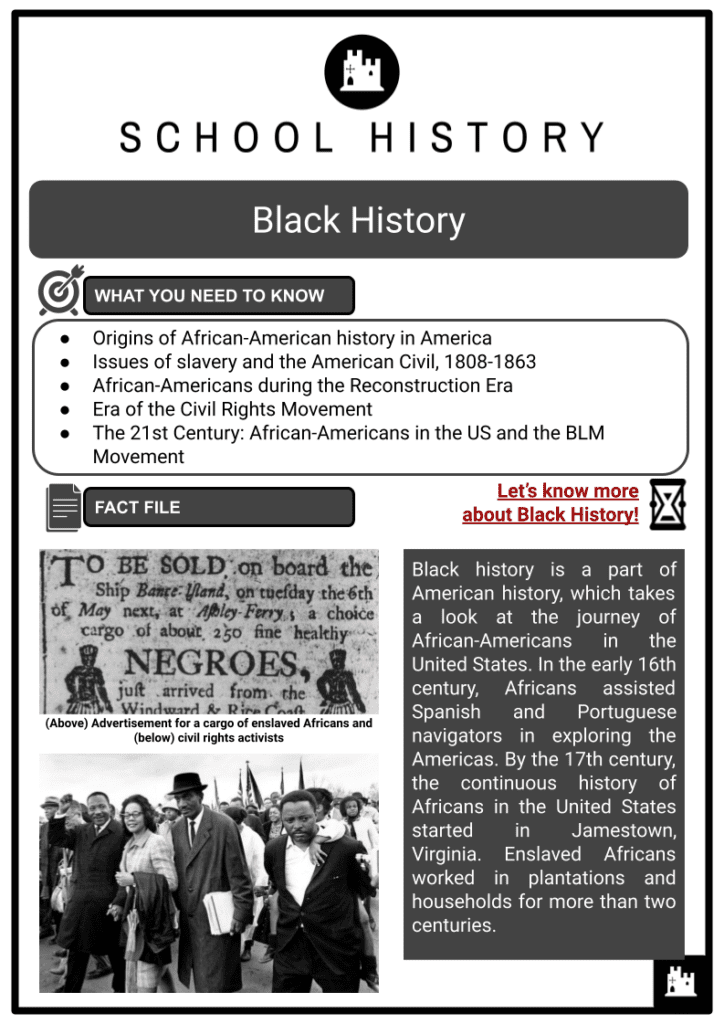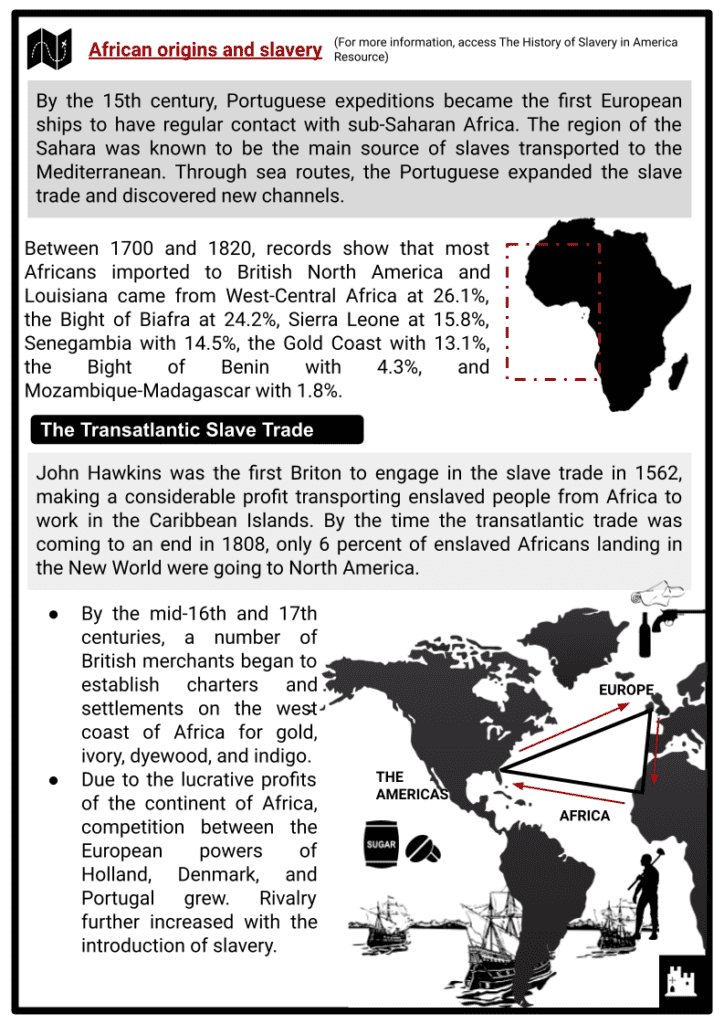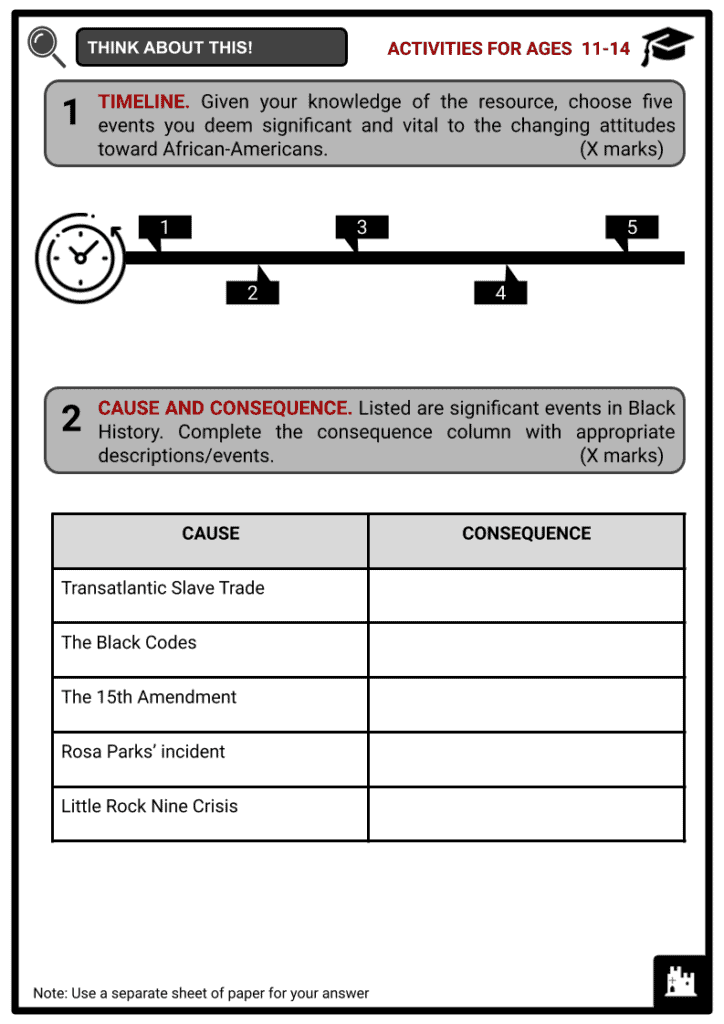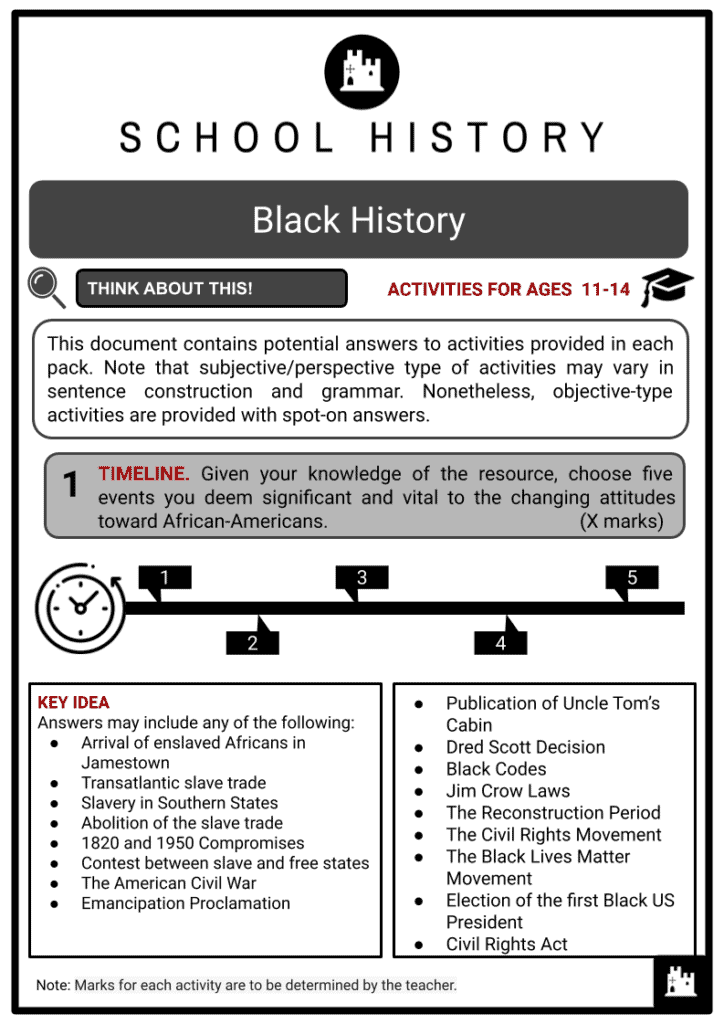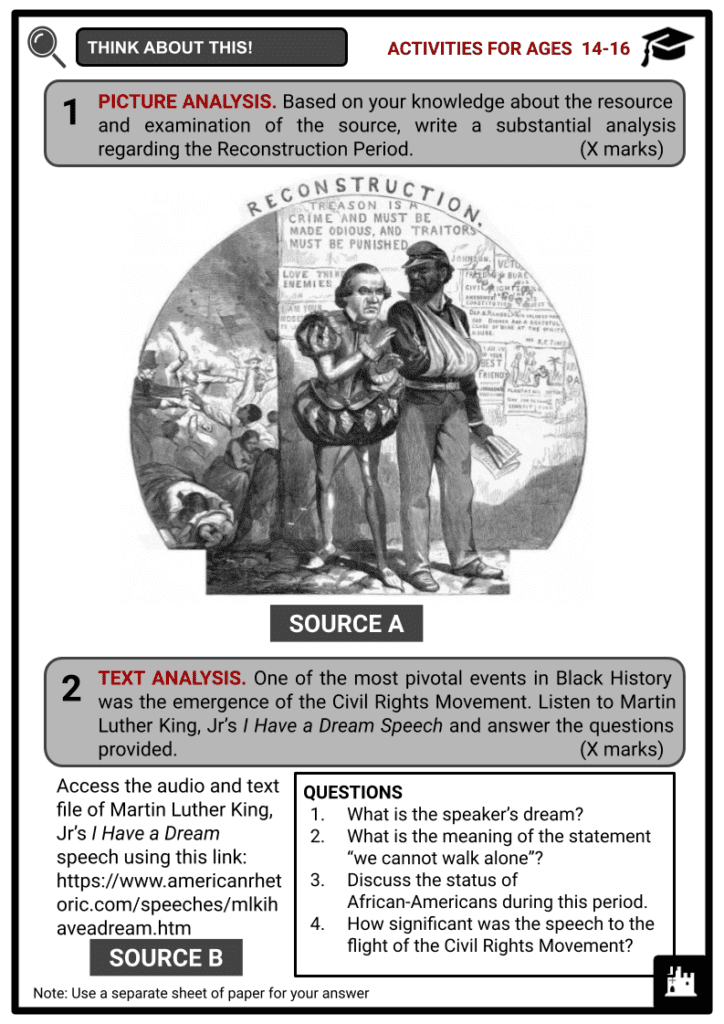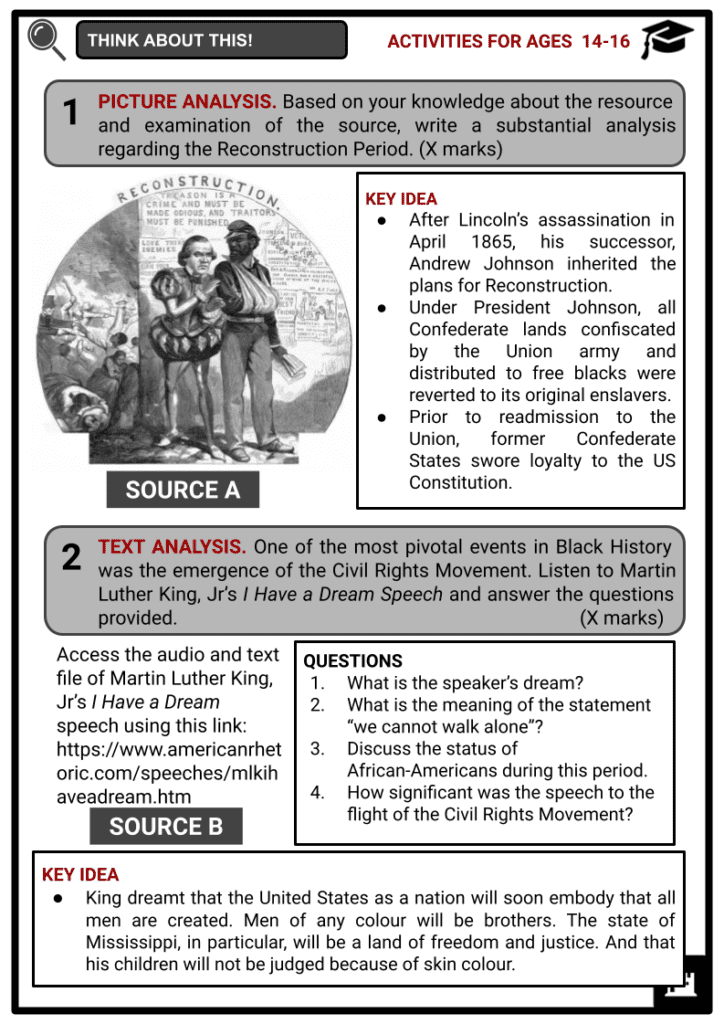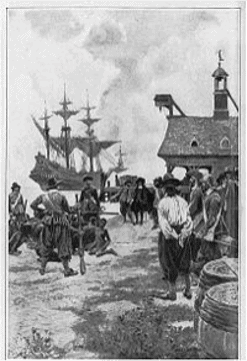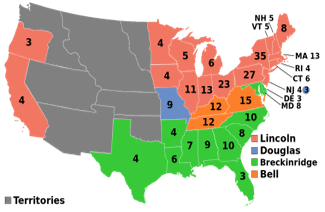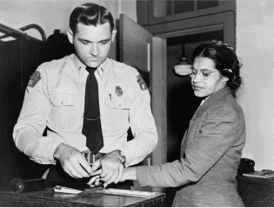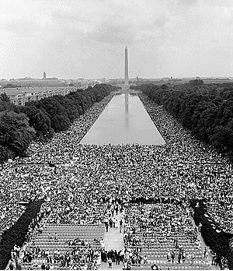Download Black History Worksheets
Do you want to save dozens of hours in time? Get your evenings and weekends back? Be able to teach Black History to your students?
Our worksheet bundle includes a fact file and printable worksheets and student activities. Perfect for both the classroom and homeschooling!
Summary
- Origins of African-American history in America
- Issues of slavery and the American Civil, 1808-1863
- African-Americans during the Reconstruction Era
- Era of the Civil Rights Movement
- The 21st Century: African-Americans in the US and the BLM Movement
Key Facts And Information
Let’s know more about Black History!
- Black history is a part of American history, which takes a look at the journey of African-Americans in the United States. In the early 16th century, Africans assisted Spanish and Portuguese navigators in exploring the Americas. By the 17th century, the continuous history of Africans in the United States started in Jamestown, Virginia. Enslaved Africans worked in plantations and households for more than two centuries.
African origins and slavery
- By the 15th century, Portuguese expeditions became the first European ships to have regular contact with sub-Saharan Africa. The region of the Sahara was known to be the main source of slaves transported to the Mediterranean. Through sea routes, the Portuguese expanded the slave trade and discovered new channels.
- Between 1700 and 1820, records show that most Africans imported to British North America and Louisiana came from West-Central Africa at 26.1%, the Bight of Biafra at 24.2%, Sierra Leone at 15.8%, Senegambia with 14.5%, the Gold Coast with 13.1%, the Bight of Benin with 4.3%, and Mozambique-Madagascar with 1.8%.
The Transatlantic Slave Trade
- John Hawkins was the first Briton to engage in the slave trade in 1562, making a considerable profit transporting enslaved people from Africa to work in the Caribbean Islands. By the time the transatlantic trade was coming to an end in 1808, only 6 percent of enslaved Africans landing in the New World were going to North America.
- By the mid-16th and 17th centuries, a number of British merchants began to establish charters and settlements on the west coast of Africa for gold, ivory, dyewood, and indigo.
- Due to the lucrative profits of the continent of Africa, competition between the European powers of Holland, Denmark, and Portugal grew. Rivalry further increased with the introduction of slavery.
- An estimated 10 to 12 million enslaved Africans were transported to the Americas between the 16th and 19th centuries.
- By 1502, Spanish conquistadors took enslaved Africans to the Caribbean. In the 17th century, English and French merchants dominated the transatlantic slave trade with human cargo from West Africa.
- The trade crossed the Atlantic Ocean, which completed the three stages of the triangular trade. Between 1640 and 1807, the British slave trade dominated the industry.
- As demand for labour intensified, the British crown expanded the slave trade in its colonies in the Americas. Through the Navigation Act of 1660, only English-owned ships were allowed to enter their colonies.
Slavery in American Colonies
- To aid the labour-intensive cultivation of tobacco in the Jamestown colony, about 20 enslaved Africans were purchased from Dutch privateers.
- To further expand the slave trade monopoly, Charles II had sole rights to the Company of Adventurers Trading in Africa. Overseen by James, the Duke of York, the British trade of gold, silver, and slaves to West Africa was monopolised.
- When white indentured servants began to leave the plantations, the labour system changed. Initially, Native Americans were forced to work on farms; however, the spread of European diseases decimated their population.
- To meet the demand for labour, plantation owners turned to enslaved Africans. In 1750, there were about 235,000 enslaved Africans, wherein 85% lived in the South. With the expansion of the slave trade, plantation farming also grew, specifically in South Carolina and Georgia.
- Although the plantations were on American soil, and although its workers were unpaid enslaved Africans, Europe possessed full control of these lands and their revenues. In essence, the overseas territories and unrewarded labour served Europe in its economic growth for centuries.
- When the British economy started flourishing and more jobs became available, cheap labour was still needed in the plantations in order to sustain the growing demand for products that were to be exported to Europe.
- Consequently, importing enslaved people from Africa became a ‘morally, legally and socially acceptable’ trend within Europe and the new colonies.
- In Virginia, tobacco plantations became dominant. By the 19th century, Southern colonies produced cotton. At the same time, many wealthy landowners planted a variety of crops including coffee, rice, sugarcane, and indigo.
- Enslaved people were primarily engaged in agriculture, which was the backbone of the Southern economy, working on indigo, tobacco, and rice plantations on the southern coast in Maryland, Virginia, and Georgia.
- They made up a tenth of the total southern population in 1680 and grew to a third by 1790.
- It is believed that the first wave of Africans in Jamestown was not described as 'slaves', but rather listed as ‘negroes’.
- Aside from being suited to the tropical climate, enslaved Africans had skills in crop cultivation. Moreover, unlike American Indians, Africans had some immunity to tropical diseases like malaria and yellow fever.
Invention of Cotton Gin and the Cotton Boom
- By 1812, there was a considerable increase in cotton farming, called the Cotton Boom, mainly because, by 1787, little to no farmers were invested in the cash crop. Initially, cotton processing was labour-intensive.
- Before the cotton gin, enslaved people could only gin one pound of cotton per day, and after its invention in 1793 by Eli Whitney, they were able to work through fifty pounds in a day. After this, they packed the cotton into bales.
- The South grew a hybrid called Gossypium barbadense, also known as the Petit Gulf, which grew well in a variety of soils and climates. It was the major cash crop in the Mississippi Valley, which included Iowa, Mississippi, Illinois, Tennessee, Texas, Louisiana, Kentucky, Arkansas, and Missouri.
- This simple mechanised device helped the struggling tobacco industry in the South to shift into large-scale production of cotton. As the shift happened, the demand for slave labour in the southern region of the United States was cemented.
Growth of Enslaved Population in the United States
- Enslaved people made up a tenth of the total southern population in 1680 and grew to a third by 1790. About 293,000 enslaved people lived in Virginia alone, making up 42% of all enslaved in the US. Maryland, North, and South Carolina had over 100,000 enslaved each.
- After the American Revolution, the South enslaved population exploded to 1.1 million in 1810 and over 3.9 million by 1860.
- However, poor food supply and horrible working conditions contributed to their high mortality rate in the Americas, especially in the Caribbean.
- Due to relatively small enslaved populations in New England and the Middle Colonies (3 to 6%), slavery had minimal impact on colonial society compared to Chesapeake and South Carolina, with significant enslaved populations.
- Like other colonial empires, enslaved people were at the bottom of the social hierarchy, with little to no legal rights.
- They were treated as property and sold in marketplaces. Aside from working hard, the lives of the enslaved were entirely dependent on their enslavers.
- Even before the end of the transatlantic slave trade, the South did not need a constant supply of forced immigrants to work as enslaved people. This was in part due to the existing and vast local population of the enslaved, and the equal male-to-female ratio of the enslaved brought into the US from the 1730s to ‘50s that resulted in an increased enslaved birth rate.
The issue of slavery and the American Civil, 1808-1863
- Decades before the outbreak of the Civil War in 1861, post-colonial America faced tension over the issues of slavery intertwined with territorial expansion and state’s rights. Historians argue that the institution of slavery was the main reason behind one of the bloodiest wars in American history.
Abolition of Slave Trade, 1808
- On 2 March 1807, the US Congress approved the enactment prohibiting slave importation within the jurisdiction of the United States of America. This law took effect on 1 January 1808, which formally abolished the slave trade.
- A known enslaver, President Thomas Jefferson promoted this law. During this time, about 4 million enslaved Africans were already in slave-holding states.
- However, historians estimate that there might have been about 50,000 enslaved people who were illegally imported through Spanish Florida and Texas.
American Colonization Society, 1817
- In 1817, the American Colonization Society was established, which sent freeborn and emancipated African-Americans to Africa. After five years, the society formed the colony of Liberia on the west coast of Africa.
- About 13,000 emigrants were sent to Liberia in 1867.
- It was Paul Cuffee, a Quaker of African-American and Native American descent who advocated the return of freed Africans to their continent of origin. His proposal was immediately supported by the British government since formerly enslaved of their own were sent to Sierra Leone.
The Missouri Compromise, 1820
- Following Thomas Jefferson’s Louisiana Purchase, members of Congress attempted to pass policies over territorial expansion and the institution of slavery. In 1820, Missouri’s application for statehood as one of the slave states caused great debate.
- Under the Missouri Compromise, Congress agreed to admit Missouri as a Slave state and Maine as a Free state. In this case, the balance in Congress remained stable. At the same time, this law prohibited slavery in Louisiana north of the 36° 30´ latitude line. It was signed into law by President James Monroe on 3 March 1820.
Nat Turner’s Rebellion, 1831
- Nat Turner, an enslaved in southern Virginia, led an uprising of about 70 enslaved Africans and killed about 60 white people. After two days of terror on several plantations, the militia infantry suppressed the rebellion.
- After the insurrection, about 55 enslaved people were executed. Due to low success rates of slave rebellions in the South, Turner’s Rebellion is considered the bloodiest.
- Despite the already limited rights, lawmakers in Virginia further prohibited enslaved people from learning how to read and write.
- Moreover, enslaved people were not allowed to assemble. Working hours in a week were extended to prohibit enslaved people from meeting with one another on Sundays.
Compromise of 1850
- With ongoing national debate and souring relations in Congress over the Wilmot Proviso, Senators Henry Clay and Stephen Douglas pursued the Compromise of 1850.
- On the other hand, slave states strengthened the enforcement of the Fugitive Slaves Act, which compelled Free states to return escaped enslaved people to Slave states. Congress also compensated Texas with $10 million.
- Supported by US President Millard Fillmore, the compromise became law in September.
- Also under the compromise, the slave trade was prohibited in Washington, D.C., but slaveholding was permitted.
- Furthermore, the compromise ended the slave trade in the capital but reinforced the existing Fugitive Slave Act.
Fugitive Slave Act
- Passed along with the Compromise of 1850, the Fugitive Slave Act required free states to return runaway enslaved people to their enslavers.
- It also tasked the federal government with finding and returning escaped enslaved people.
- In response, the states of Vermont and Wisconsin passed measures to nullify the law.
Publication of Uncle Tom’s Cabin, 1852
- On 20 March 1852, Harriet Beecher Stowe published her anti-slavery novel, Uncle Tom’s Cabin. Three months upon publication, about 300,000 copies were sold. It is believed that Stowe gained inspiration for her novel when she encountered enslaved people in the Underground Railroad.
- Her novel was a reaction to the tightening of the Fugitive Slave laws. Many regarded her work as a catalyst or groundwork for the American Civil War.
- By the 1850s, her work further fueled abolitionist sentiments in the North, while Southerners were outraged.
- The character of Uncle Tom was a faithful and enduring enslaved person to his enslaver.
Underground Railroad
- Upon the passage of the revised Fugitive Slave Act, the Underground Railroad reached its peak.
- The Underground Railroad was a network of people who helped enslaved Africans to run away North.
- The earliest account was recorded in 1831 when enslaved Tice Davis escaped Kentucky. Based on reports, most runaways came from Kentucky, Virginia, and Maryland.
- Known as conductors, abolitionists helped fugitives reach stations or safehouses. These private homes were then run by stationmasters.
- The most common routes were through Ohio-Indiana-Iowa and Pennsylvania-Detroit-Canada.
Kansas-Nebraska Act, 1854
- In 1854, Kansas and Nebraska were established as territories. The decision of whether to join the Union as a Free or Slave state lay on popular sovereignty. Under popular sovereignty, as proposed by Stephen Douglas, residents of both territories would decide by popular referendum on allowing slavery or not.
- As a result, many northerners and southerners poured into Kansas to increase their numbers in the debate. In the fall of 1855, pro-slavery and anti-slavery advocates engaged in violence. The event became known as Bleeding Kansas.
- By the time Kansas joined the Union, the Civil War had already begun in 1861. The act divided Democrats and Whigs, who later joined the new anti-slavery Republican Party.
Bleeding Kansas
- After the passage of the Kansas-Nebraska Act, northern and southern settlers flooded into Kansas to influence the decision. As a result, violence between pro- and anti-slavery forces erupted. This period of violence became known as Bleeding Kansas.
- The term Bleeding Kansas was first coined by Horace Greeley, an anti-slavery publicist from the New York Tribune.
Dred Scott v. Sanford Decision, 1857
- In 1857, the Dred Scott decision confirmed the legality of slavery in the southern states and the westward expansion, but the abolitionist movement convinced southerners that the north was bent on dismantling the institution of slavery.
- Also known as Dred Scott v. Sanford, the case of freedom by an enslaved African lasted a decade. Dred Scott was born into slavery in 1799 in Virginia. He moved with his owner, Peter Blow to Alabama.
- By 1830, Scott moved to St Louis, Missouri. Both Alabama and Missouri were slave states.
- Two years later, Blow died, and Scott was bought by Dr John Emerson, who later moved him to Illinois and to the Wisconsin territory - where slavery was outlawed under the Missouri Compromise.
- While in Wisconsin, Scott married Harriet Robinson - also an enslaved - whose ownership was transferred to Emerson.
- In 1837, Emerson met and married Eliza Sanford when he moved to Louisiana, a Slave state. After several months, Scott followed Emerson. By October 1838, the Emersons and their enslaved people returned to Wisconsin.
- In 1843, John Emerson died in Iowa. His enslaved people became his wife’s property. When Sanford returned to Missouri, he denied Scott from buying his freedom.
- Dred and Harriet Scott filed lawsuits against Irene Sanford in April 1846. Under two Missouri statutes, (1) Any person of any colour is allowed to sue for wrongful enslavement, and (2) Any person taken to a free territory would gain freedom and could not be subjected to slavery if returned to a Slave state.
- The Scotts received support from abolitionists, churchmates, and the Blow family, who once enslaved Dred.
- After a retrial in 1850, Scott won his freedom. The lower court’s decision in 1852 was reversed by the Missouri Supreme Court. On 15 May 1854, Scott and his family were enslaved again after the reversal by the federal court.
- On 11 February 1856, Scott’s trial reopened after his appeal to the US Supreme Court. The following year, he lost his fight for freedom. Chief Justice Roger Taney said that all people of African descent (free or enslaved) were not citizens of the United States, and therefore had no right to sue. Moreover, he justified that under the Fifth Amendment, enslaved people were the legal property of their enslavers.
Election of Abraham Lincoln, 1860
- With divided Democrats, Abraham Lincoln was elected as the 16th President of the United States in November 1860. He won the election with 180 electoral votes and nearly 40% of the popular vote against candidates Douglas, Breckinridge, and Bell.
- The 1860 election identified the Democratic and Republican Parties. It also intensified the division between slave and free states of the South and the North.
- Carrying the anti-slavery agenda of the new Republican Party, Lincoln’s election angered pro-slavery politicians.
Militia Act, 1862
- On 17 July 1862, Congress approved the enlisting of black soldiers into the Union army, a change of policy. The Militia Act authorised the enlistment of any persons of African descent in the militia to suppress the rebellion.
- Infantry units composed of African-Americans were formed in New Orleans, Louisiana, Kansas, and South Carolina. In February 1863, Massachusetts governor John A. Andrew issued the first official call for African-American soldiers.
- About one-quarter of the soldiers recruited to the 54th Massachusetts Infantry Regiment came from slave states, while others were from Canada and the Caribbean. It was the first African regiment formed in the North.
- In July 1863, the 54th Massachusetts guarded Port Charleston, South Carolina.
- In the initial months following the recruitment of African-Americans, they were paid $10 a week, compared to $13 for white soldiers. In 1864, Congress passed a bill that authorised equal pay for both.
- When the war ended in 1865, about 180,000 African-American soldiers served in the army. Half were former southern enslaved people, while the rest were either free African-Americans from both border and northern states.
Emancipation Proclamation, 1863
- On New Year’s Day, Lincoln issued the Emancipation Proclamation, which liberated some three and half million enslaved people in rebellious states. Lincoln explained that the proclamation was a wartime measure for states under rebellion. The proclamation did not cover Border states and Southern states controlled by the Union Army.
- Despite having little effect on the institution of slavery, the Emancipation Proclamation got the attention of Britain and France, who had considered supporting the Southern cause. Foreign observers backed off due to opposition to slavery.
- About 200,000 African-Americans joined the Union Army, which greatly contributed to its victory.
- When the war ended, Lincoln’s Emancipation Proclamation became the basis of the 13th Amendment, which constitutionally abolished slavery in the United States.
Slavery in Southern States
- In 1787, during the Constitutional Convention in Philadelphia, delegates were divided on the morality of slavery.
- By this time, about 700,000 enslaved Africans were already in America. Southern states of the Carolinas and Georgia argued that the slave population should be counted along with whites.
- This proposal was opposed by Northern states because they believed that it would give a huge advantage to southern states.
- As a result, the Three-Fifths clause was passed by the delegates, which counted 5 enslaved people as 3 people for taxation and representation.
- Prior to the outbreak of the American Revolutionary War, southern colonies were the main source of tobacco exports.
- By the end of the 17th century, Britain imported more than 20 million pounds of tobacco annually.
- After the war, demand for tobacco decreased, while a new cash crop, cotton emerged.
- By the early 19th century, the South faced political and economic pressure with the emergence of abolitionist sentiments in the North.
- This resulted in growing tensions and differences between the North and the South.
- In Congress, tariffs were passed to protect Northern businesses from foreign competition, but it badly hurt the southern economy.
- In order to protect their interests, Southern states seceded from the Union, which gave rise to the American Civil War in 1861.
African-Americans during the Reconstruction Era
- Following the turbulent years of the American Civil War, the United States underwent the Reconstruction Era between 1865 and 1877. During this period, the American federal government sought to reintegrate former Confederate states into the Union. Under the presidency of Andrew Johnson, Reconstruction Amendments were passed to recognise African-American communities and rights. However, Southern states were able to pass local statutes which neglected the amendments.
Southern States during the Reconstruction Period
- Even before the end of the Civil War in 1865, President Abraham Lincoln already had reconstruction plans for the South. Prior to his assassination, he proposed that free blacks and those who enlisted in the Union militia should be granted the right to vote.
- After Lincoln’s assassination in April 1865, his successor, Andrew Johnson, inherited the plans for Reconstruction.
- Under President Johnson, all Confederate lands confiscated by the Union army and distributed to free blacks were reverted to their original enslavers.
- Prior to readmission to the Union, former Confederate States swore loyalty to the US Constitution. They were also obliged to pay war debts and complied with the 13th Amendment.
Black Codes
- Mississippi and South Carolina were the first Southern States that enacted black codes in late 1865. In the case of Mississippi, they required formerly enslaved to have written employment documents. Those who broke labour contracts were arrested and punished.
- In South Carolina, blacks were limited to work as farmers or servants, unless they could pay an annual tax of $10 to $100.
- In both states, formerly enslaved, were levied with penalties. They were often punished into forced plantation labour.
- In some states, black people were restricted from owning certain property.
- Those who disobey were subjected to arrest, beating, or forced labour.
Reconstruction Act of 1867
- In the Congressional elections of 1866, radical Republicans dominated Congress. Overriding Johnson’s presidential veto, Congress passed the Reconstruction Act of 1867.
- This act temporarily divided former-Confederate States into five military districts to be governed by governors until approval of state Constitutions by the Congress.
- All males, regardless of race, but excluding former Confederate leaders, were granted the right to participate in state constitutional conventions.
- New state constitutions were required to stipulate universal manhood suffrage regardless of race.
- All former Confederate states were required to ratify the Fourteenth Amendment before readmission to the Union.
Reconstruction Amendments
- Ratified in 1865, the 13th Amendment to the US Constitution abolished slavery in the United States.
- It states that “Neither slavery nor involuntary servitude, except as a punishment for crime whereof the party shall have been duly convicted, shall exist within the United States, or any place subject to their jurisdiction.”
- Ratified in 1868, the 14th Amendment to the US Constitution granted citizenship to all persons born or naturalised in the United States, including formerly enslaved. With this, all citizens shall enjoy equal protection of the laws.
- Adopted into the Constitution in 1870, the 15th Amendment granted male citizens the right to suffrage.
- It disregarded a person’s race, colour, and previous condition of servitude.
- Despite the passage of the 13th, 14th, and 15th Amendments, white southerners were able to expand the black codes, which ensured their superiority and the survival of the plantation-based economy.
- All former Confederate States were readmitted to the Union by 1870. Amidst the existence of the black codes, some southern blacks won the election to southern state governments. Moreover, a couple also reached the US Congress during this period.
White Supremacist
- During the Reconstruction Period, white southern extremist groups turned to violence in response to the changes of the era.
- One of the most infamous racist groups was the Ku Klux Klan. They targetted and intimidated local Republican politicians and African-Americans, who they deemed to be threats to white supremacy.
- By the 1870s, the group was able to re-establish Democratic supremacy in the South.
- They were known for wearing masks and long white robes and hoods while attacking their targets at night.
- Other organised racist groups in the South included the White League in Louisiana and the Knights of the White Camelia.
- Both aimed to destroy reconstruction governments, attack southern Republicans and intimidate, and sometimes kill, African-Americans.
- Aside from eliminating the Republican Party in southern states, white supremacist groups wanted to return the black population to forced labour.
Post-Reconstruction Period
Jim Crow Laws
- Rooted in the Black Codes, the Jim Crow Laws were a series of state statues, which legalised racial segregation.
- It was named after a Black minstrel character and meant to marginalise African-Americans in the United States amidst the passage of the Reconstruction Amendments.
- The laws consisted of three things:
- Racial segregation in public places, such as schools, building entrances, hospitals, parks, accommodations, and transportation. Moreover, white neighbourhoods forbade African-American settlers.
- Disenfranchisement of black men’s right to vote by the imposition of literacy tests and other forms of intimidation.
- Prohibition of miscegenation or interracial marriage between whites and blacks.
- In New Orleans, prostitutes were segregated according to race. Textbooks in some states were separated for black and white students.
- By the early 20th century, race riots and lynchings became prevalent in the United States.
- By 1920, huge numbers of educated African-Americans left the South. This became known as the Great Migration.
The Great Migration
- Between 1916 and 1970, about 6 million Southern African-Americans relocated to the North and West of the United States.
- Mainly due to the Jim Crow laws, violence against black communities, and less to nothing economic opportunities, educated African-Americans left the South.
Reasons behind the Great Migration?
- Push Factors
- Economic depression in the South due to floods and pests
- Racial oppression through Jim Crow laws
- Pull Factors
- Better living conditions, jobs, and wages in the North and West
- Laws that decreased European immigration to the US
- Industrial work during WWI and WWII
- Better civil opportunities
- Due to the booming African-American population in the North, tension over housing developed. As a result, African Americans created their own communities in cities. One of the best examples is Harlem in New York City, which became the heartland of African-American culture.
- The Harlem Renaissance was an artistic movement created by African-Americans in the North.
- It began a new era of the Negro Movement or activism.
Era of the Civil Rights Movement
- In the 1950s, African-Americans formed the civil rights movement to fight for their equal rights under the US Constitution. Despite the existence of Reconstruction Amendments, black communities continued to endure racial segregation and discrimination in America, especially in Southern states. The increase in civil rights activities during the post-World War era led to the gradual removal of Jim Crow Laws.
World War II and African-Americans
- When the Second World War broke out, by 1941, war-related work increased in the United States. Initially, African-Americans were paid less than white Americans.
- Moreover, they were discouraged from enlisting in the military.
- On 25 June 1941, US President Franklin Roosevelt issued Executive Order 8802, which opened jobs in the government to all Americans regardless of national origin or race, thus, granting African-Americans equal employment rights.
- The first African-American military aviators in the US Army Air Corps were the Tuskegee Airmen.
- Amidst experiencing segregation and discrimination, many African-American men and women continued to serve in the war effort in the United States.
- In 1948, President Harry S. Truman issued Executive Order 9981, which ended racial discrimination in the US military.
- During the last year of the war, more African-American troops were positioned as infantrymen, pilots, medics, tankers, and officers.
Brown v. Board of Education Case, 1954
- On 17 May 1954, under the Brown v. Board of Education case, the US Supreme Court ruled that racial segregation in public schools was unconstitutional as it violated the 14th Amendment. It reversed the 1896 verdict on the Plessy v. Ferguson case and denounced the ‘separate but equal’ doctrine.
- In 1951, Oliver Brown filed a suit against the Board of Education of Topeka, Kansas for denying his daughter, Linda Brown to enter an all-white elementary school.
- His lawsuit argued that racial segregation in schools violated the equal protection clause of the 14th Amendment.
Montgomery Bus Boycott, 1955
- From 5 December 1955, until 20 December 1956, the first large-scale African-American demonstration against segregation took place in Montgomery, Alabama. The boycott began with the arrest of Rosa Parks, an African-American woman who was arrested upon refusing to give her bus seat to a white man.
- On 1 December 1955, Parks, who was seated in the front row of the coloured section of the bus, refused to vacate her seat for a white man. As a result, she was arrested and fined $10, with an additional $4 for court fees.
- Four days later, the Women’s Political Council, or WPC, began circulating flyers for a bus boycott in Montgomery.
- The next day, civil rights leader Martin Luther King, Jr. supported the boycott and voiced African-American demands, including the hiring of black drivers and a first-come first-seated policy.
- About 75% of Montgomery’s bus ridership was African-Americans. Many used organised carpooling, biking, and walking, which sustained the boycott.
- As a result, on 5 June 1956, the local federal court ruled that racially segregated seating on buses was against the 14th Amendment. By 21 December 1956, with the support of the US Supreme Court, buses in Montgomery were integrated, which also ended the boycott.
- Amidst the court decision, many showed resistance. Bus stops were still segregated and, in some instances, snipers began firing at buses. In January 1957, King’s house was bombed. The perpetrators, who were members of the Ku Klux Klan, were later arrested.
- African-American sentiments about segregation were heard on the United States and the international stage. Moreover, Rosa Parks became a historical figure in Black history.
- In 1955, Montgomery, Alabama issued a city ordinance that segregated bus seats between African-Americans and whites. Specifically that the former should yield their seats to white riders in case the front half reserved for them was full.
- After the success of the boycott, King emerged as a leading civil rights movement leader. He founded the Southern Christian Leadership Conference, or SCLC, which aimed to end segregation in the south.
- The Montgomery bus boycott lasted for 381 days.
Little Rock Nine Crisis, 1957
- In September 1957, the Little Rock Nine Crisis led to the desegregation of Central High School. Despite local white support for segregation, US President Dwight Eisenhower provided protection for African-Americans against racial discrimination in schools.
- After the Supreme Court's decision in Brown v. Board of Education in 1954, nine African Americans enrolled at Little Rock Central High School in the summer of 1957.
- However, this all-white school denied them entrance to the premises. A white mob verbally harassed and threatened to kill them.
- Under the order of Arkansas governor Orval Eugene Faubus, about 270 soldiers from the state National Guard blocked the school entrance. Faubus was known for opposing the desegregation of schools.
- The event drew national and international attention to issues of racism, civil rights, and state and federal power.
- While under discussion, the nine students stayed at home. When they returned to the high school, violent white protesters attacked them.
- On 25 September under the orders of President Dwight Eisenhower, federal troops guarded the nine students as they entered the school. They also enforced desegregation and prohibited white violence. Despite this, the Little Rock Nine continued to experience verbal and physical threats from white students. Ernest Green became the first African-American to graduate from Little Rock Nine Central High School in 1958.
Freedom Riders, 1961
- In 1961, Freedom Riders composed of African Americans and white civil rights activists participated in rides in protest of segregated bus terminals.
- In addition to freedom rides, they attempted to use white-only restrooms, waiting rooms, and counters. As a result, white officers threatened them with violence.
- The original Freedom Riders were composed of seven African-Americans and six whites, who left Washington D.C. on 4 May 1961.
- They travelled through the South beginning in Virginia and North Carolina.
- About 200 white people attacked the Freedom Riders’ bus in Alabama on May 14, 1961. While all members escaped the burning bus, they were brutally beaten by the mob.
- In a short time, members abandoned the group. It was Diane Nash, a member of the SNCC (Student Non-Violent Coordinating Committee) who organised a new group of 10 to continue the cause. They travelled from Nashville, Tennessee.
- To secure the protection for the new riders, US Attorney General Robert F. Kennedy negotiated with Alabama governor, John Patterson.
- Moreover, Attorney General Kennedy ordered the deployment of about 600 federal marshals to contain and stop the violence.
Martin Luther King, Jr. and his I Have a Dream speech, 1963
- On 23 August 1963, Martin Luther King, Jr., a young Baptist minister and president of the SLCC (Southern Christian Leadership Conference delivered his I Have a Dream speech before a crowd of about 250,000 people at the March on Washington.
- By the summer of 1963, Bayard Rustin, along with other leaders of the Big Six civil rights organisations planned the March on Washington for Jobs and Freedom.
- Leading civil rights organisations included the National Association for the Advancement of Colored People (NAACP), National Urban League (NUL), Congress On Racial Equality (CORE), and the Student Nonviolent Coordinating Committee (SNCC).
- Among the goals of the march included their demands for desegregation of public schools and accommodations, such as restaurants, theatres, hotels, and waiting areas.
- Moreover, they demanded that the federal government redress violations of their constitutional rights.
- In terms of employment, they sought the expansion of federal training programs for employees.
Civil Rights Act, 1964
- First proposed by President John F. Kennedy, the Civil Rights Act was signed by his successor Lyndon B. Johnson. This act legally ended racial segregation in public places and prohibited employment discrimination based on colour, sex, race, and religion.
- In favour of the bill, the Senate voted 73-27. On 2 July 1964, Democratic President Johnson signed the bill into law.
- The law also created an Equal Employment Opportunity Commission.
- It also prohibited the use of federal funds to pursue any discriminatory program.
Voting Rights Act, 1965
- Also signed into law by President Johnson, the Voting Rights Act secured and reinforced the 15th Amendment to the Constitution, which granted African Americans the right to vote.
- The act particularly broke down any legal barriers at the state level, which hindered African-Americans from exercising their constitutional right to vote.
- The advancement of voting-rights laws became one of the main platforms of Lyndon Johnson when he ran for the presidency in 1964.
- Prior to this act, African-Americans were hindered from voting due to a perceived lack of literacy skills. Election officials often pointed out that they filled out application forms incorrectly. As a result, many were forced to take deliberately discriminatory literacy tests, which they often failed.
- In most Southern states, African-Americans were required to recite the US Constitution. On 26 May 1965, the US Senate passed the bill with 77-19 votes.
- To support the implementation of this law, in 1964, the 24th Amendment made poll taxes illegal in national elections.
- While in 1966, the US Supreme Court also banned poll taxes in state and local elections.
Fair Housing Act, 1968
- Days following the assassination of civil rights leader Martin Luther King, Jr., Congress passed the Fair Housing Act of 1968 which prohibited discrimination in the sale, rental, and financing of housing based on colour, religion, race, or sex.
- Racial segregation in housing resulted in white Americans moving from cities to the suburbs, which reduced employment opportunities for African-Americans.
- Despite its passage, most housings in the United States remained segregated in the following years.
- By 1988, Congress passed the Fair Housing Amendments Acts, which expanded its scope to include people with disabilities and pregnant women.
The 21st Century: African-Americans in the US and the BLM Movement
- Today, African-American or Black history is celebrated in the United States every February. This month honours the struggles and achievements of African-Americans throughout US history. Pivotal events include slave rebellions, emancipation, the Great Migration, and the civil rights movement. Moreover, it highlights African-American contributions to politics, art, and culture.
Secretary of State Colin Powell, 2001
- Between 1989 and 1993, Colin Powell, a Vietnam War veteran and US Army general served as chairman of the Joint Chiefs of Staff. Under President George H.W. Bush, Powell played a significant role in the first Persian Gulf War.
- In 2001, Powell became the first African-American to be appointed as Secretary of State. President Bush gave Powell the task of seeking international support during the 2003 US invasion of Iraq.
- Succeeding Powell in 2004 was Condoleezza Rice, the first African-American woman to serve as Secretary of State.
Election of US President Barack Obama, 2008
- The son of a Kenyan and American, Barack Obama was elected as the 44th President and 1st African-American to hold the highest executive position in the United States in 2009.
- The young Obama grew up in Hawaii before immigrating to Chicago. In 1996, he began his political career in Illinois.
- A graduate of Harvard Law School, Obama served the State Senate for eight years before his candidacy in the US Senate.
- Known as an eloquent orator, Obama became a party name after he delivered a speech at the annual Democratic National Convention.
- In November 2008, Obama dominated the Democratic general election and defeated former first lady and New York senator, Hillary Clinton, and Arizona senator, John McCain.
- Obama’s candidacy in 2008 inspired many African-Americans to cast their votes. Moreover, a substantial increase in new voter registrations was also recorded.
- In 2012, he was re-elected for a second term after defeating Mitt Romney.
US Postal Service and 12 civil rights pioneers, 2009
- In 2009, 12 civil rights pioneers were immortalised on postage stamps. Commemorative stamps of Thurgood Marshall, Ella Baker, Daisy Bates, J.R. Clifford, Medgar Evers, Fannie Lou Hamer, Charles Hamilton Houston, Ruby Hurley, Mary White Ovington, Joel Elias Spingarn, Mary Church Terrell, Oswald Garrison Villard, and Walter White were released in the US.
Black Lives Matter Movement, 2013
- In 2013, Alicia Garza, Patrisse Cullors, and Opal Tometi founded the Black Lives Matter Network. Through a Facebook post in July 2013, the term ‘Black lives matter’ was used in response to the Zimmerman v. Martin case.
- On 26 February 2012, a man from Florida named George Zimmerman shot and killed Trayvon Martin, an unarmed 17-year-old African-American. The victim’s death ignited nationwide protests against white supremacy and violence against Black communities.
- Zimmerman admitted to shooting Martin but argued it was self-defence. The jurors found him not guilty of charges of murder or manslaughter.
- On 13 July 2013, the hashtag #BlackLivesMatter was first mentioned on Twitter. Like wildfire, it began to spread relating to high-profile deaths of African-American civilians.
- According to Mapping Police Violence, an advocacy group, African-Americans are 2.5 times as likely as white Americans to be killed by police officers.
- The large states of California, Texas, and Florida have the highest number of African-American killings by police officers.
- The deaths of Eric Garner in New York, Michael Brown in Missouri, Tamir Rice in Ohio, and Freddie Gray in Maryland also sparked protests.
- On 25 September 2016, the Black Lives Matter movement gained national attention after a number of NFL players kneeled in protest during the national anthem.
George Floyd Protests in the United States and worldwide call for racial justice
- In the middle of the COVID-19 pandemic in 2020, the Black Lives Movement reached new heights after the murder of George Floyd by police officer Derek Chauvin in Minneapolis, on 25 May 2020.
- Caught on camera, Chauvin kneeled on Floyd’s neck for more than eight minutes despite protests Floyd couldn’t breathe. The action led to his death.
- As a result, four officers were fired, Chauvin was charged with second-degree murder and second-degree manslaughter, while the other three were sued for abetting murder.
- Prior to Floyd, Ahmaud Arbery and Breonna Taylor were also killed by police officers in 2020.
- Since the death of Floyd, about 450 major protests were held in towns and cities across the United States.
- The Black Lives Matter movement gained support from both African Americans and white Americans.
- Major protests called to ‘Defund the police’ and reinvestment in social services.
- In response to the protest, the Minneapolis City Council voted to dissolve its police department and fund social services for communities of colour.
- Mayor Muriel Bowser of Washington, DC announced on June 5, 2020, that a street near the White House would be renamed to Black Lives Matter Plaza.
- Since 2015, the Black Lives Matter movement has expanded to other parts of the world.
- In Australia, the BLM movement organised protests against police officers’ maltreatment of Aboriginal Australians.
- Like in Australia, the Canadian chapter of the BLM movement is addressing racial injustice experienced by the indigenous population.
- In support of BLM in the USA, the UK chapter held similar protests in several places, including outside the US Embassy.
Image sources:
- https://en.wikipedia.org/wiki/African-American_history#:~:text=The%20uninterrupted%20history%20of%20blacks,of%20European%20descent%20(whites)
- https://en.wikipedia.org/wiki/Slave_Trade_Act_1807
- https://en.wikipedia.org/wiki/1860_United_States_presidential_election
- https://www.britannica.com/biography/Rosa-Parks
- https://en.wikipedia.org/wiki/March_on_Washington_for_Jobs_and_Freedom

